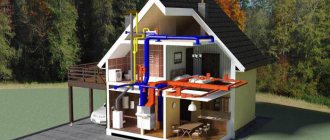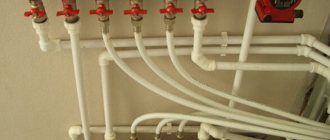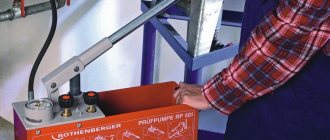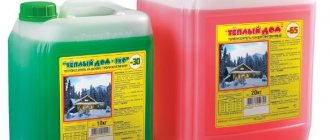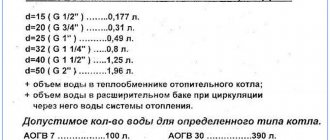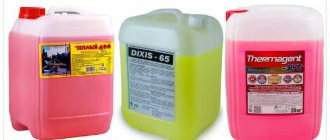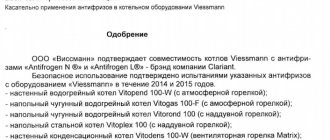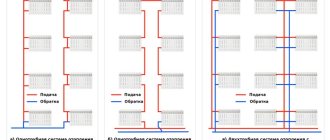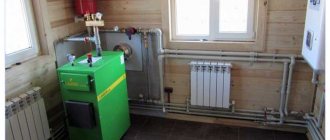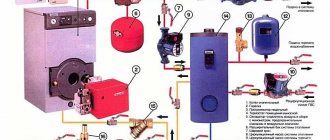The reliability of the heating system of a private home largely depends on the choice of coolant. But with all the wealth of choice of coolants or antifreezes on the market, it is simply impossible to find the ideal option “for all times and peoples.”
What is the difference between different antifreezes for heating, what are the limits of their use, what are the features of operation - all this will be discussed further.
- Coolant for heating - basic information and characteristics
- The best coolant is water?
- The importance of corrosion control, the dangers of zinc pipes
- Coolants of heat supply systems: types and features
- Design features of the heating system when using antifreeze
- Selecting a circulation pump
- Antifreeze service life
Coolant Ecotherm Superconcentrate
Coolant for heating - basic information and characteristics
First, let's define what a coolant is. The coolant for a heating system is a liquid substance used to transfer thermal energy from a heat source to heating devices. Sometimes steam is used to transfer heat, but not in domestic heating systems.
Based on the definition, you can understand what qualities the coolant should have:
- transfer the maximum amount of heat from the heating boiler to the radiators;
- ensure the lowest possible heat loss during this transfer;
- have low viscosity - otherwise the speed and temperature of the coolant in the system will drop, and losses will accordingly increase;
- do not cause corrosion of pipes and radiators through which it passes;
- do not leak or leak;
- be safe to use.
The cost of the coolant is also important, especially in our time. But let’s make a reservation right away - the stingy pays twice, and it’s better not to save on coolant.
Let's also figure out the difference between coolant and antifreeze. Antifreeze is a general name for liquids that do not freeze at low temperatures. Let us remember that among the requirements for the coolant is safety in operation. One of the main sources of danger in our latitudes is freezing of the coolant due to a gas or electricity cut-off and, as a result, a complete failure of the entire heating system of the house. To prevent this, it is recommended to use antifreeze as a coolant. Although some believe that the best coolant is water.
Propylene glycol: what you need to know
This substance is a colorless liquid with a slight specific odor and sweet taste. Widely used in the food industry and in the manufacture of liquids for electronic cigarettes. This completely safe and environmentally friendly substance became available to Russian consumers only at the end of the last century, but immediately received universal recognition and well-deserved popularity.
Solutions based on propylene glycol are not aggressive and have excellent performance characteristics as a CO coolant. Freezing point and density vary depending on the concentration of the active substance.
Ready-made mixtures based on propylene glycol have a significant drawback - high cost. You have to pay for quality! Propylene glycol-based antifreeze liquids are colored green by manufacturers.
Many of our compatriots ask the question: how to make a high-quality and safe non-freezing coolant for a heating system with your own hands? There is nothing simpler: a solution of ethyl alcohol (technical) in water in a percentage ratio of 7:1 will not freeze at 10°C and will be completely safe for humans and CO.
The best coolant is water?
When it comes to choosing a coolant for heating a home, water is often cited as the best option. Is it so? Let's try to figure it out. Undoubtedly, water has many attractive properties, the main ones being its low price and availability. And this factor often outweighs all others.
Vyacheslav Sidorov, Commercial Director of VintChem
“Today there are many antifreezes on the Russian market, among them there are also high-quality ones that have long proven themselves to be the best, whose manufacturers maintain a high standard for the quality of their products. But, there are also many cheap, glycerin-based and counterfeit antifreezes that can damage your expensive heating system - beware of such counterfeits and antifreezes.”
Water has excellent heat capacity (that is, it can transfer the greatest amount of heat), low viscosity, it is non-toxic and fireproof in case of leaks. And if a leak does occur, then adding water to the heating system is not a big deal.
But water also has disadvantages. Firstly, tap water causes corrosion of pipes and heating devices. Secondly - and this is the main drawback that neutralizes all the positive properties - water freezes at only 0°C. And that’s not all - when water freezes, it expands by about 9%, which inevitably leads to ruptures of pipes and radiators and failure of the entire heating system. If for some reason the temperature in the house drops to negative values, and there is water left in the pipes, a tragedy is inevitable. Thus, the risks when operating a system in which the coolant is water are very high.
Of course, there are ways to deal with shortcomings. For example, to combat corrosion, anti-corrosion additives are used to reduce salt deposits on the walls of pipes, and distilled water is used. To reduce the freezing point, special additives are also used.
It turns out that, despite its “aqueous” nature, most often it is not tap water that circulates in the heating system, but a certain solution. By the way, no one fills their car with plain water, only antifreeze, so why should it be different in the heating system?
Types of antifreeze
Today, the Russian market widely presents non-freezing liquids for heating systems made on the basis of the following components:
- Propylene glycol.
- Ethylene glycol.
- Glycerin.
- Rassolov.
- Alcohol.
Each of the components presented above has its own advantages and disadvantages. There are also common problems inherent in all antifreezes for the home heating system.
- Lower (than water) heat capacity. The difference is 20-30%
- High viscosity due to increased density.
In addition, the components of these “anti-freeze” agents have a rather aggressive effect on CO elements, including seals.
Important! Antifreeze should not be brought to a boiling point, which for some solutions is more than 100°C. The main components decompose and lose their performance properties.
To eliminate these negative factors, most manufacturers of non-freezing liquids introduce various additives and inhibitors into their composition, which increase the boiling point of the solution, the effect on metals and seals, which reduce the foaming of the composition.
Today, the most common antifreezes are those made from propylene glycol or ethylene glycol. Further, we will talk about them.
The importance of corrosion control, the dangers of zinc pipes
Corrosion is dangerous because... Over time, it compromises the integrity of the system and causes leaks. But these are not all of its negative aspects. The formation of rust in pipes and radiators reduces their efficiency, because... the corrosion layer has a thermal conductivity approximately 50 times less than that of the metal.
| Other TopClimat.ru publications on the topic | |
| Antifreeze in heating systems | |
| Choosing a boiler room for a private house | |
In other words, the heat transfer from radiators decreases at the same boiler operating mode. In addition, the speed of the coolant in the system decreases, which also reduces its overall efficiency. In general, corrosion in the system leads to the fact that part of your expensive fuel will go to waste, and this share will only grow over time.
But that's not all. Rust particles are separated from the walls of the pipes under the influence of the coolant flow and negatively affect the bearing of the circulation pump, which can leak, and clog the channels of the heat exchangers and heating boiler.
Rust is often combated using galvanized pipes, which have good corrosion resistance. But, remember! Elements containing zinc, in particular pipes galvanized on the inside, should not be used in heating systems. The fact is that at operating temperatures (which is +70°C and above) of the coolant, the zinc coating will peel off and settle on the heating elements of the boiler, and the anti-corrosion properties of the coolant itself will be significantly weakened.
Heating scheme for a private house
The exception is glycerin-based coolant, but it is better not to take risks in this case either. Often, manufacturers of glycerin-based coolants sell mixed formulations that contain glycerin and propylene glycol.
The importance of coolants in a car
During fuel combustion and engine operation, part of the thermal energy is spent on heating the block and cylinder head. The intensity of heat transfer depends on the operating mode and ambient temperature.
Excessive overheating causes a malfunction of the ignition system and changes in the gaps between moving parts, which leads to jamming of the car's power plant.
To remove excess heat, a liquid cooling circuit with a separate radiator, centrifugal pump, thermostat and mechanical or electrically driven fan is used.
Coolants of heat supply systems: types and features
The most effective coolants are antifreezes, which do not lose fluidity at subzero operating temperatures and also practically do not expand when frozen. Today, aqueous solutions of ethylene glycol, propylene glycol, other glycols, glycerin-based compositions, solutions of some inorganic and organic salts, transformer oils, and alcohol solutions are most often used as coolants. Let's look at the capabilities and distinctive features of these antifreezes.
Ethylene glycol aqueous solution
One of the main characteristics of any coolant is its operating temperature range. Ethylene glycol solution is used at operating temperatures from -20°C to +130°C. Although these coolants at certain concentrations can remain in the liquid phase down to temperatures of the order of -70°C, their use in this low-temperature region becomes impossible due to the excessively high viscosity.
But even if the temperature of the water-ethylene glycol solution drops below -20°C, the heating system will not fail due to pipe rupture. A coolant with an ethylene glycol concentration of 40% when frozen (freezing temperature ~ -30°C) expands in volume by only 1.5%. Accordingly, its linear expansion will be only 0.5%, and this is safe for almost any structural materials. In this case, ethylene glycol freezes gradually. Compare this to water freezing very quickly and expanding by 9%!
Most often, the upper temperature limit for ethylene glycol-based antifreeze is limited to 108°C - 110°C. If this threshold is crossed, the antifreeze begins to foam, the substance decomposes with the formation of acid and solid sediment, and the system becomes airy.
Antifreezes are marked with a specific color
Speaking about an aqueous solution of ethylene glycol, one cannot fail to mention its toxicity. Ethylene glycol should not be allowed to get into food products or drinking water to avoid poisoning. A dose of ethylene glycol that is dangerous to human life if it enters the stomach is considered to be 100 ml. Although if antifreeze accidentally gets on your hands or clothes, it is easily washed off with water without causing any harm.
Aqueous solution of propylene glycol
Coolants based on ethylene glycol and propylene glycol are quite similar in their characteristics. But there is also a significant difference - propylene glycol does not have a toxic effect, so it can be used even in double-circuit boilers. In addition, an aqueous solution of propylene glycol, unlike a solution based on ethylene glycol, has a lubricating effect, which facilitates the operation of the circulation pump.
But it is also more expensive than ethylene glycol.
On a note
“In heating systems, elements containing zinc cannot be used, in particular, pipes galvanized on the inside. The fact is that at operating temperatures (which is +70°C and above) of the coolant, the zinc coating will peel off and settle on the heating elements of the boiler, and the anti-corrosion properties of the coolant itself will be significantly weakened.”
Aqueous solution based on glycerin
This solution is non-toxic. Its cost is lower than that of propylene glycol. Operating temperature range: from -30°С to +110°С. Glycerin-based solutions do not damage galvanized pipes from the inside.
But this antifreeze also has its drawbacks. If an aqueous solution of glycerin is used, then the requirements for sealing parts increase: glycerin dissolves the stuffed seals of threaded connections. And even with high heating, such a solution foams strongly, which leads to losses during heat removal, and there is a risk of air locks forming in the heating system.
In addition, glycerin is heavier than ethylene and propylene glycols - this must be taken into account when developing a project.
Salt solutions
Most often, such solutions are used not in heating systems, but in the secondary circuits of refrigeration units, which are operated at negative operating temperatures - mainly at temperatures below -20°C. This is due to their relatively low viscosity in these temperature conditions, compared to similar glycol-based coolants.
The main disadvantage of salt-based antifreezes, which prevents their use in heating systems, is their high corrosion activity, which, however, is significantly reduced at low temperatures.
Antifreeze HotBlood 30 Eco based on propylene glycol
Transformer oils
Special oils, such as transformer oils, can also be used as a coolant. The main advantage of this solution is that the oil can operate at very high temperatures. Therefore, it has found application in industrial heating systems as an alternative to superheated steam. The main disadvantage of oil is its flammability. Even a small leak in the system can lead to a fire. In addition, oil is quite expensive.
Alcohol solutions
These solutions have limited use and are currently used only in sealed heating systems that have forced circulation, since alcohol simply evaporates from open systems.
Also, aqueous-alcohol solutions have the smallest range of operating temperatures, because their boiling point is less than 100°C. But they are distinguished by their low price, low penetrating ability and are non-toxic.
Water as a coolant for heating systems
Water is the simplest and cheapest coolant. Usually, under normal conditions, it is practically not consumed (remains in the system). In many ways, it depends on its quality.
If the heating system operates constantly, freezing of the system is impossible. In this case, it is better not to drain the water from the system, even in the summer, to avoid corrosion of the system.
If the water contains additional impurities (metal particles, salts, etc.), it must be passed through a special filter. This will protect your heating system from sudden breakdowns.
The main disadvantages of water as a coolant include its ability to form scale, sediment, etc. In this case, heat transfer decreases, as a result of which fuel consumption increases (be it gas, waste oil, etc.).
Design features of the heating system when using antifreeze
Most manufacturers of household heating equipment produce models designed for operation using antifreeze as a coolant. Still, it is better to clarify this in the documentation for the equipment. To avoid unpleasant surprises. The fact is that the use of antifreeze in systems designed for water is impossible.
There are a number of design features that you should know before designing a heating system for a private home if you intend to use antifreeze:
- the increased viscosity of antifreeze leads to the fact that you will need to install a powerful circulation pump capable of moving the coolant, even if it begins to thicken;
- since the heat capacity of any antifreeze is 15% or more lower than that of water, the amount of heat transferred by them will be less, which means you will need larger radiators;
- the high fluidity of antifreeze leads to the fact that you will have to carefully seal detachable connections. To seal these connections, it is better to use Teflon or paronite gaskets;
- due to the large volumetric thermal expansion of antifreeze, it is necessary to provide a closed expansion tank in the system;
- some antifreeze (ethylene glycol) is toxic, so it cannot be used in double-circuit boilers - only in single-circuit boilers.
Antifreeze based on propylene glycol
Less dangerous to human life and health. It is important to remember that such antifreeze must contain special additives, taking into account the fact that seals in the heating system can be made of various metals, which can be destroyed as a result of using an unsuitable component. Additives that reduce foaming, prevent the oxidation process when oxygen enters the heating system, etc. are extremely important. In this case, there should be no inhibitors that make polymer materials brittle.
Anti-freeze agents with propylene glycol are allowed to be used in double-circuit boilers, because their accidental penetration into drinking water, as well as leaks at detachable connections, will not cause harm to people. Propylene glycol coolants, in addition to the same general positive characteristics as ethylene glycol, have a lubricating effect inside the heating system, reduce hydrodynamic resistance and facilitate the operation of secondary circuit pumps. The heat transfer of propylene glycol antifreeze is higher than that of ethylene glycol. These are the ones that can be safely used in open systems. True, there are also disadvantages - they cost 2-2.5 times more than ethylene glycol ones.
Selecting a circulation pump
To choose the right circulation pump, you can use a small cheat sheet. The pump performance is calculated based on the total volume of the heating system. The easiest way to determine it is to fill the system completely with water and bleed the air, then drain the water from the circuit into a measuring container with the air valves open.
Each coolant from a specific manufacturer’s line has its own operating ranges
The minimum coolant speed in domestic heating systems is 0.5 m/s; this speed prevents the deposition of salts on the walls of the pipes. As a rule, the coolant speed is selected in the range from 0.7 to 1 m/s. If the coolant speed exceeds 1 m/s, the pump will create excessive noise during operation. The performance of the circulation pump depends on the speed.
Making the right choice
How to make the right choice regarding the substance responsible for heat transfer and heating the house? To do this, it is worth analyzing the operating conditions of the heating system and how and what it is made of. Ordinary water can become the optimal coolant, for example, if the temperature in the heating circuit (even in extreme cold outside) in the house is not lower than +5 degrees. Otherwise, it is better to think about buying antifreeze. At the same time, when choosing antifreeze, they take into account its threshold temperature values, composition, shelf life, environmental friendliness and safety, as well as the possibility of interaction with elements of the heating system.
How to choose antifreeze for your heating system
On a note! It is best to choose propylene glycol antifreeze. It is not dangerous to health, and in a number of characteristics it is better than others.
Coolant for heating system of a country house
In general, it is worth choosing a coolant at the time when the design of the entire heating system is being developed. This will allow you to select the right equipment - it is not so easy to convert a water system for anti-freeze.
Table of coolant indicators
Antifreeze service life
Despite the fact that manufacturers often indicate the service life of antifreeze at 7-8 years, practitioners believe that the coolant will not last more than 5 years without updating. And it seems that this assessment is fair. But 5 years is quite a long time. To avoid problems, remember that in any case, the service life of antifreeze depends on its operating mode.
It is not recommended to bring coolant based on glycols or glycerin to a boil (the boiling point at atmospheric pressure is 106°C-116°C, depending on the degree of dilution of antifreeze with water).
When the coolant is locally overheated to temperatures exceeding +170°C, thermal decomposition of ethylene glycol will occur, the formation of “carbon deposits” on the heating elements, the release of gaseous decomposition products and the destruction of anti-corrosion additives.
Therefore, proper circulation of the coolant must be ensured in heating boilers, and the heating elements must be completely immersed in the coolant during operation to prevent them from overheating and “burning” the antifreeze.
Another factor affecting the suitability of antifreeze is the tightness of the heat exchange system. It is known that ethylene glycol oxidizes upon contact with atmospheric air, and the oxidation process accelerates with increasing temperature—approximately doubling for every 10°C. The oxidation products of ethylene glycol - glycolates - destroy anti-corrosion additives and lead to increased corrosion. Therefore, it is necessary, if possible, to exclude contact of the coolant with air, in particular, to use sealed expansion tanks.
Finally, some advice for those who decide to change the antifreeze in the heating system. Before adding new antifreeze, it is best to flush the system. And to quickly remove air bubbles from the coolant, after filling the system, it is kept without pressure for 2-3 hours.
Antifreeze
The advantages of antifreeze are obvious . First, it does not freeze, up to temperatures of -60, -65 degrees, you can completely turn off the heating, and when you need to turn it on, without fear of the system defrosting. Secondly, antifreeze practically does not oxidize metals, there will be no scale or rust (just as the heating efficiency will not decrease over time). Third, antifreeze heats up much faster than water (by about 10%), and it also holds the temperature longer (it takes longer to cool, by the same 10%), so your boiler turns on less often, which means it saves you money on gas or electricity.
The disadvantages of antifreeze are also very significant. The first is its price, 20 liters of antifreeze cost about 1500 - 1800 rubles, here is a photo.
And in a house-apartment system, you need so much, even if you dilute it to -35 degrees. It will take several tens of thousands of rubles to fill the system.
Secondly, you need to go and buy antifreeze to constantly maintain a certain freezing temperature.
Third, antifreeze is toxic, it is undesirable to spill it on carpets or floors at home, it then begins to release harmful substances.
RESULT
In conclusion, I would like to say from personal experience - I had one friend who completely filled the heating system of his house (200 square meters) with antifreeze, it turned out to be quite a lot of money - about 30,000 rubles (and he bought it in barrels, it’s cheaper). YES it heats up faster and cools down slower, the pipes do not rust inside, there is no need to wash them - but the price is 30,000 rubles!!! Now, if you fill in plain water, then for 30,000 rubles, you can “get confused” and flush the system every two years, or change some current pipes in 5–7 years (and the pipes are now plastic, and the radiators are aluminum, practically not rust). That is, water is definitely easier and cheaper! However, if your house may not be heated in winter (the heating is turned off) and you do not live in it for weeks, then there is definitely antifreeze, otherwise the entire system will freeze and collapse!
Water
Let's start, of course, with plain water.
There are quite a few advantages here . Firstly, water is practically free (and if you have your own well drilled, it’s completely free). Secondly, it is almost always available (it is available 24 hours a day from the tap, there is no need to go to stores and buy it), so you can always add it to your heating system without problems. Thirdly, water is not toxic, if you spill it you don’t need to dispose of it, just wipe it with a rag and that’s it. Fourthly, it heats up well and tolerates heat well, which is why it is used in heating systems. Fifthly, it has good fluidity, is not viscous, and therefore is suitable even for thin heating pipes.
BUT there are also disadvantages and they are no less significant . Firstly, water oxidizes metals very well, rust appears, and then deposits that clog your radiators (heating efficiency drops significantly). Secondly, if you heat the water to more than 80 degrees, scale can be deposited on the walls of pipes and radiators, which also clogs the pipes and reduces heating efficiency. Thirdly, water freezes already at “0” degrees, which means that the system cannot be left unplugged in winter; the water will simply freeze and destroy the pipes and boiler. Fourthly, according to research, heating water requires about 10% more energy (gas or electricity), which means you spend more money on heating. Also, water cools faster than antifreeze, water needs to be heated more often, which means gas or electricity consumption increases (you pay more money). And lastly, it is advisable to flush the system every year, otherwise it may simply become clogged with rust and deposits.
Coolant properties
A good coolant for heating systems should ensure maximum operating efficiency of the heating boiler and transfer as much heat as possible over a certain amount of time.
Main characteristics of the coolant:
- efficiency of heat supply; this indicator determines the efficiency of the system;
- corrosion protection and lubrication of heating system elements;
- freezing point;
- coolant viscosity;
- safety of the liquid in operation.
The choice of coolant type is also influenced by the cost of the product. Even an ideal coolant for a heating system in all respects, the price of which is very high, will not be in demand among consumers, since it will not ensure a quick payback for the system.
The main types of coolants used in our country are water and antifreeze.
The design of the entire system and its efficiency depend on what kind of coolant you decide to buy for the heating systems in your home. For example, for a private house heating with pump circulation can be used. Let's take a closer look at what advantages and disadvantages antifreeze or water has in the heating system, and what should be chosen for private households.
Water in the heating system
The predominant use of water is explained by its highest heat capacity among all liquids and no less high density. For example, a kilogram of water with a temperature of 90ºС, cooling in a radiator to 70ºС, releases heat in the amount of 20 kcal.
Water is the safest, environmentally friendly and inexpensive coolant
Of course, water differs from synthetic substances in its toxicological and environmental properties; it is absolutely safe for people. In case of a leak, it will not cause much trouble, and its deficiency can be easily compensated by pouring the missing amount of liquid into the system. This coolant has no competitors in terms of cost - there is no cheaper liquid.
Attention! It is not recommended to use ordinary water in heating systems, since it is rich in oxygen and salts, and this causes scale and corrosion to appear over time.
For the system to function smoothly, the water must be softened. There are two rational ways:
- Thermal, based on elementary boiling. The water is placed in a large metal tank and heated. During the boiling process, carbon dioxide is removed, salts are deposited at the bottom of the vessel. Unfortunately, persistent calcium and magnesium compounds will remain in the water.
- Chemical, acting through reagents. With the help of soda ash, slaked lime, and sodium orthophosphate, the salts in water become insoluble and precipitate. Subsequent filtration will remove any remaining substances.
The ideal option is distilled water, the only disadvantage of which lies in its purchase, while regular water can be obtained from the tap. Many people use rainwater, which compares favorably with tap water, wells and artesian water.
In the case of water, the parameters of the heating system coolant play a big role, namely the temperature regime. As soon as the air temperature in the building drops below 0ºC, the liquid in the pipes will freeze, which threatens serious damage to the heating system.
Incompatibility of an electric heating boiler and modern coolants (video)
When choosing a coolant for an autonomous heating system, analyze the technical characteristics of the installed equipment and the influence of weather factors. Having made a choice in the direction of antifreeze, be sure to calculate the costs and study the possible risks associated with its operation. Perhaps setting the minimum coolant temperature during your absence will save money, which will be spent on purchasing antifreeze and upgrading equipment.
- Author: Victor Kaploukhiy
Thanks to my varied hobbies, I write on various topics, but my favorites are engineering, technology and construction. Perhaps because I know many nuances in these areas, not only theoretically, as a result of studying at a technical university and graduate school, but also from the practical side, since I try to do everything with my own hands. Rate this article:
(1 vote, average: 5 out of 5)
